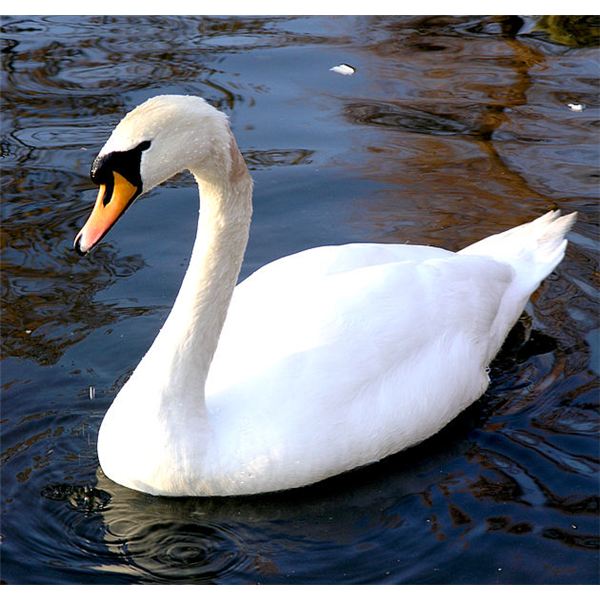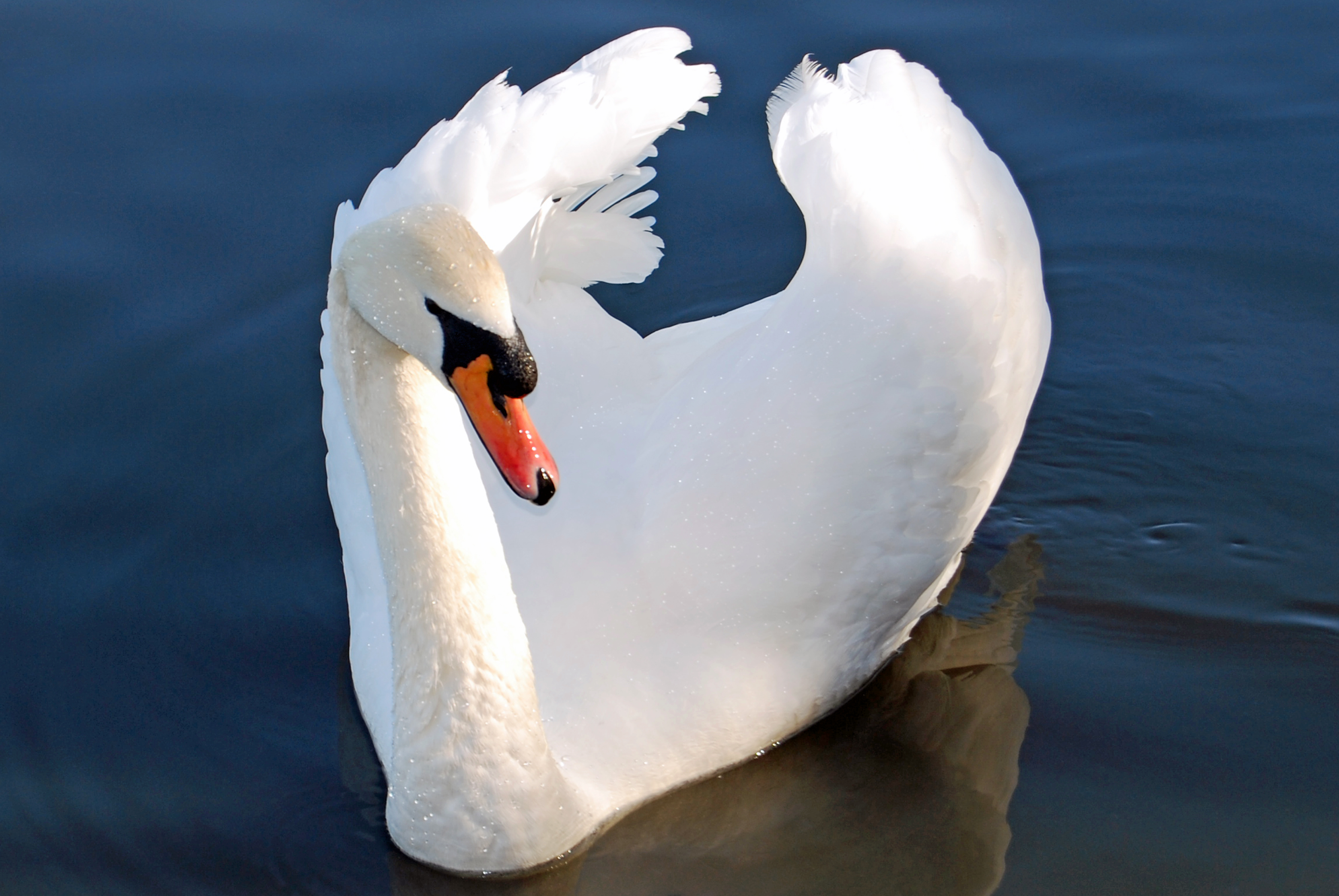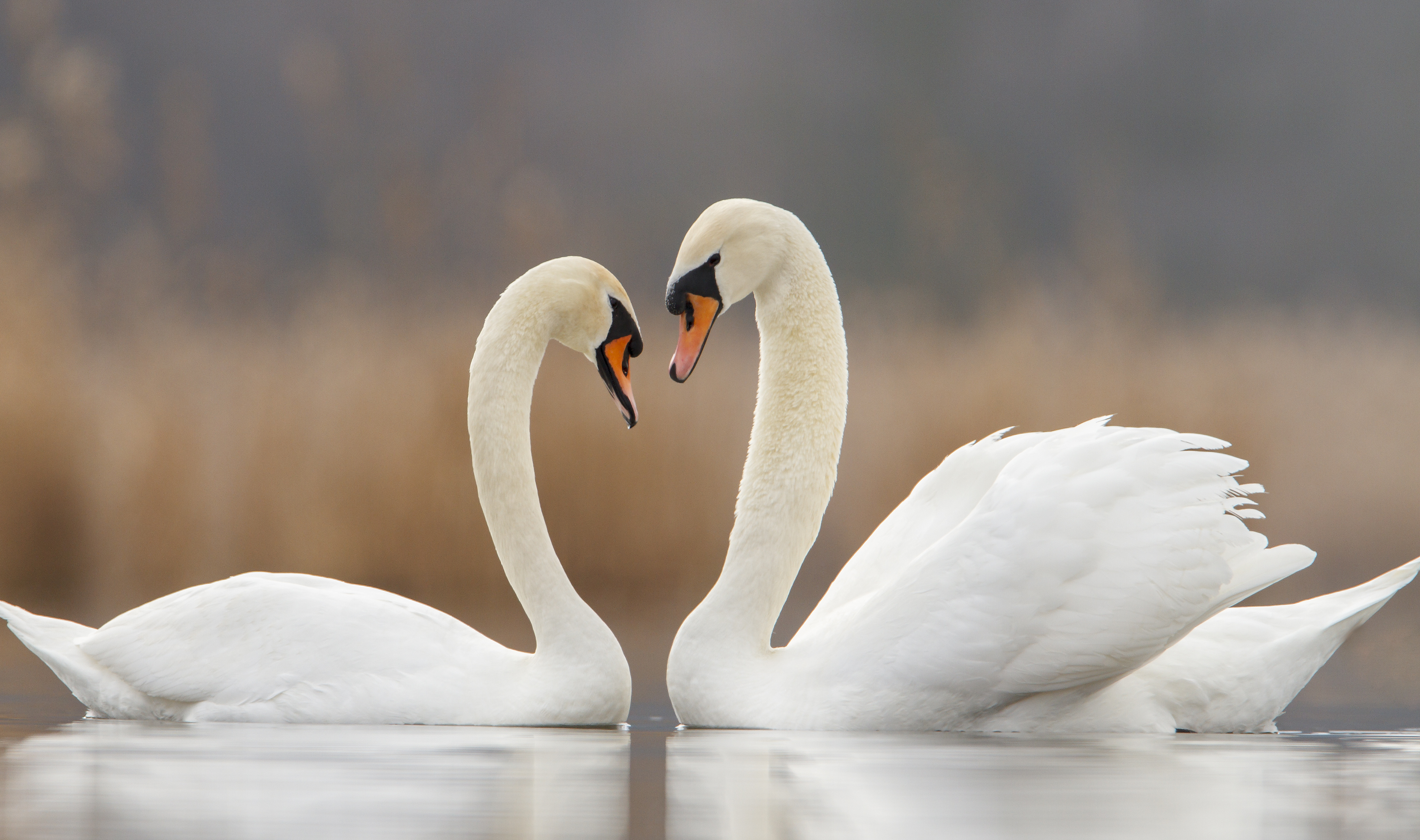
Swans, the largest members of the waterfowl
family of birds, have snow-white feathers and
graceful necks. There are eight swan species,
which inhabit rivers, lakes, and ponds on every
continent except Antarctica. They eat both on land
and in water; their diet consists of land plants and
grasses, aquatic plants, fish, and invertebrates.
Swans must dig much of their aquatic food from
bottom mud, after dipping their necks far into the
water to reach it.
Many American swans nest around the Arctic
Ocean and Hudson Bay. In winter, they migrate in
a V-formation to the Carolinas at airspeeds up to
sixty miles per hour, filling the air with sounds
ranging from deep bass notes to those like clarinets.
Swans that live in more temperate climates,
such as the Great Plains of the United States, do
not migrate. Eastern hemisphere swans include
European whistling swans and Bewick's swans.A
scarlet-billed black swan inhabits Australia. The
initial ugliness of cygnets, which only lasts for a
year, was the inspiration for Hans Christian
Andersen's fairy tale "The Ugly Duckling."
Physical Characteristics of Swans
Swans reach a maximum length (from beak to tail
tip) of six feet, and weigh up to thirty-five pounds.
Their plumage is usually white, white plus black,
or rarely all black. Whooping (whooper), Bewick's,
whistling, mute, and trumpeter swans are white.
Black-necked swans have black areas on white
bodies. Wingspans range from six to ten feet.
Swan necks are long and slender, usually held
in a graceful S-curve. Trumpeters, whoopers, and
whistlers, however, hold their necks straight upright.
Swans have two short legs with huge, scalecovered,
webbed feet. The tips of their strong bills
are broad and flat, for optimum use in tearing underwater
plants, a major part of their diet. Swans
often feed by poking their heads underwater.
They are not graceful on land, but fly, swim, and
dive very well. All swans, including "mute"
swans, hiss, bark, whistle, whoop, and cluck, especially
when migrating.
The Lives of Swans
Swans form flocks to breed, nest, feed, and migrate.
Depending on species, a flock has between a
few dozen and thousands of individuals. Swans
also form family units, comprising a set of parents
with their offspring, within flocks. All swans
choose mates for life. On mating, swans build
nests from plants, twigs, and down, which they
use over and over. Then the pens lay five to ten
pale-colored eggs and incubate them until they
hatch, after eighteen to thirty-nine days.
Cygnets, covered with gray to brown down,
leave their nests a few days after hatching, following
their parents to learn to swim and find food.
Although the pen is usually responsible for the
eggs, once the cygnets are born, the cob may feed
and protect them. They fly for the first time at age
four months. Most Northern Hemisphere swans
breed yearly. Southern Hemisphere swans breed
every two years. A swan is mature at age three
or four and can live for twenty to thirty years
in the wild or forty to fifty years in captivity.
Swan Conservation
South Americans, Europeans, Asians, and North
Americans hunted trumpeters and other swans
almost to extinction by eating swan meat, and using
their feathers for pens, hat decorations, and
women's scarves. By the 1930's, many species
were in trouble; for example, under one hundred
trumpeter swans were alive at that time. Legislation
and protective actions have enlarged swan
populations by allowing them to increase by natural
reproduction.
Swan Facts
Classification:
Kingdom: Animalia
Subkingdom: Bilateria
Phylum: Chordata
Class: Aves
Order: Anseriformes
Family: Anatidae (ducks, geese, and swans)
Tribe: Anserini
Genus and species: Three genera and twelve species,
including Cygnus columbianus (whistling
swan), C. cygnus (whooping swan), C. bewickii
(Bewick's swan), C. melancoryphus (blacknecked
swan), C. buccinator (trumpeter swan),
C. olor (mute swan); Chenopis atrata (black
swan); Coscoroba coscoroba (Coscoroba swan)
Geographical location: Every continent except
Antarctica
Habitat: Rivers, lakes, ponds, swamps, and moist
forest areas
Gestational period: Incubation of twenty-five to
forty-five days
Life span: Twenty to thirty years in the wild; forty
to fifty years in captivity
Special anatomy: Long necks in S-curves or
straight upright; short legs with scaled, webbed
feet; broad, flat, strong bills
Other popular Animals
Photo Gallery of - Swan








 Animalia Life
Animalia Life